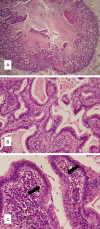KRAS mutation-positive bronchial surface epithelium (BSE)-type lung adenocarcinoma with strong expression of TTF-1: a case providing a further insight as for the role of TTF-1 in the oncogenesis
- PMID: 26823891
- PMCID: PMC4713677
KRAS mutation-positive bronchial surface epithelium (BSE)-type lung adenocarcinoma with strong expression of TTF-1: a case providing a further insight as for the role of TTF-1 in the oncogenesis
Abstract
Bronchial surface epithelium (BSE)-type lung adenocarcinoma is a subtype of non-terminal respiratory unit (TRU)-type lung adenocarcinoma originating in the bronchial surface epithelium. However, there are few known cases of BSE-type adenocarcinoma with marked expression of thyroid transcription factor-1 (TTF-1). This paper describes a very rare case of KRAS mutation-positive BSE-type adenocarcinoma that exhibited strong expression of TTF-1 that was putatively involved in oncogenesis. An 84-year-old woman, a never smoker, was referred to our hospital because of an abnormal chest radiograph. Chest computed tomography (CT) showed a solid mass lesion, 15 mm × 10 mm, with a relatively smooth margin in the left upper lobe. The patient underwent partial resection of the left upper lobe for strongly suspected lung cancer with a clinical stage of cT1aN0M0. Histopathological findings showed continuous migration of papillary, hyperplastic, atypical columnar tumor cells originating from normal bronchial surface epithelium, leading to a diagnosis of BSE-type adenocarcinoma. TTF-1 was strongly expressed in almost 100% of the tumor cells, which tested positive for the KRAS mutation. TTF-1 has recently attracted attention as an oncogene, and it is purportedly involved in the carcinogenesis and survival of lung adenocarcinoma cells. There is typically an inverse correlation between the respective expressions of KRAS and TTF-1, but in the present study, they appeared simultaneously and were both putatively involved as oncogenic driver alterations. This case is important in that it sheds some light on the largely unknown pathogenic mechanism of BSE-type adenocarcinoma.
Keywords: BSE-type adenocarcinoma; KRAS; TTF-1.
Figures




Similar articles
-
Non-terminal respiratory unit type lung adenocarcinoma has three distinct subtypes and is associated with poor prognosis.Lung Cancer. 2014 Jun;84(3):281-8. doi: 10.1016/j.lungcan.2014.03.013. Epub 2014 Mar 27. Lung Cancer. 2014. PMID: 24725383
-
High mesothelin expression in advanced lung adenocarcinoma is associated with KRAS mutations and a poor prognosis.Oncotarget. 2015 May 10;6(13):11694-703. doi: 10.18632/oncotarget.3429. Oncotarget. 2015. PMID: 26028668 Free PMC article. Clinical Trial.
-
The Value of Cytokeratin 5/6, p63 and Thyroid Transcription Factor-1 in Adenocarcinoma, Squamous Cell Carcinoma and Non-Small-Cell Lung Cancer of the Lung.Turk Patoloji Derg. 2015;31(2):81-8. doi: 10.5146/tjpath.2015.01302. Turk Patoloji Derg. 2015. PMID: 25944390
-
Identification of a metastatic lung adenocarcinoma of the palate mucosa through genetic and histopathological analysis: a rare case report and literature review.BMC Cancer. 2019 Jan 11;19(1):52. doi: 10.1186/s12885-019-5277-1. BMC Cancer. 2019. PMID: 30634950 Free PMC article. Review.
-
NKX2-1/TTF-1: an enigmatic oncogene that functions as a double-edged sword for cancer cell survival and progression.Cancer Cell. 2013 Jun 10;23(6):718-23. doi: 10.1016/j.ccr.2013.04.002. Cancer Cell. 2013. PMID: 23763999 Review.
Cited by
-
Progression inference for somatic mutations in cancer.Heliyon. 2017 Apr 11;3(4):e00277. doi: 10.1016/j.heliyon.2017.e00277. eCollection 2017 Apr. Heliyon. 2017. PMID: 28492066 Free PMC article.
-
Identifying behavior regulatory leverage over mental disorders transcriptomic network hubs toward lifestyle-dependent psychiatric drugs repurposing.Hum Genomics. 2025 Mar 19;19(1):29. doi: 10.1186/s40246-025-00733-w. Hum Genomics. 2025. PMID: 40102990 Free PMC article.
References
-
- Yatabe Y, Mitsudomi T, Takahashi T. TTF-1 expression in pulmonary adenocarcinomas. Am J Surg Pathol. 2002;26:767–73. - PubMed
-
- Maeshima AM, Omatsu M, Tsuta K, Asamura H, Matsuno Y. Immunohistochemical expression of TTF-1 in various cytological subtypes of primary lung adenocarcinoma, with special reference to intratumoral heterogeneity. Pathol Int. 2008;58:31–7. - PubMed
-
- Sumiyoshi S, Yoshizawa A, Sonobe M, Kobayashi M, Sato M, Fujimoto M, Tsuruyama T, Date H, Haga H. Non-terminal respiratory unit type lung adenocarcinoma has three distinct subtypes and is associated with poor prognosis. Lung Cancer. 2014;84:281–8. - PubMed
-
- Park WY, Kim MH, Shin DH, Lee JH, Choi KU, Kim JY, Park do Y, Lee CH, Sol MY. Ciliated adenocarcinomas of the lung: a tumor of nonterminal respiratory unit origin. Mod Pathol. 2012;25:1265–74. - PubMed
-
- Yatabe Y, Kosaka T, Takahashi T, Mitsudomi T. EGFR mutation is specific for terminal respiratory unit type adenocarcinoma. Am J Surg Pathol. 2005;29:633–9. - PubMed
Publication types
MeSH terms
Substances
LinkOut - more resources
Full Text Sources
Medical
Miscellaneous
